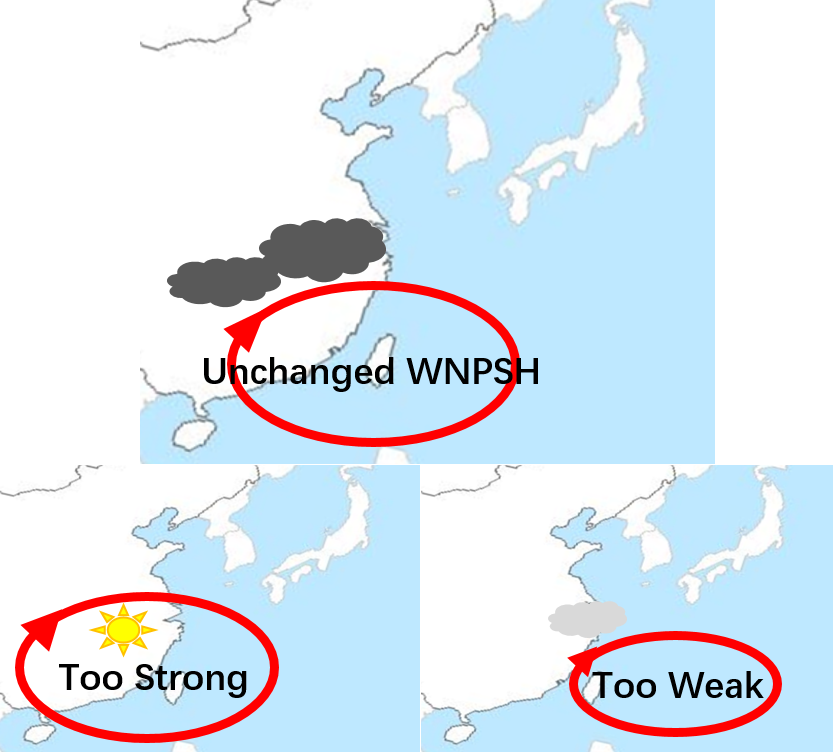Climate models are indispensable tools for future climate projection including the Mei-yu front rainfall, which is the major rain-bearing system of the East Asian summer monsoon. Adaptation of climate changes relies heavily on the data of climate projection from the Coupled Model Intercomparison Project (CMIP). However, resolutions of CMIP models such as CMIP5 are generally around 100-200KMs, which are not high enough to resolve some regional rainfall systems, for instance, the Mei-yu rain belt along the Yangtze River valley. Uncertainty in regional rainfall projection due to model resolution needs to be quantified.
Recently, Dr. CHEN Xiaolong and Prof. ZHOU Tianjun from the Institute of Atmospheric Physics, Chinese Academy of Sciences, cooperating with Drs. Peili WU and Malcolm ROBERTS from Hadley Centre, UK Met Office, investigated the effect of model resolution on the mei-yu rainfall projection using the Hadley Centre’s latest climate model, HadGEM3-GC2. The high-resolution HadGEM3-GC2 (N216, ~60km) projects large increases of summer rainfall under two representative concentration pathway scenarios (RCP8.5 and RCP4.5) whereas the low-resolution (N96, ~130km) shows a decrease. A larger increase of projected Mei-yu rainfall in higher-resolution models is also observed across the CMIP5 ensemble.
Why do climate models employing different resolutions show such large differences in the projected rainfall changes?

Too strong or too weak western North Pacific Subtropical High leads to less Mei-yu rainfall, which is more prone to happen in future projection with a coarse resolution model. (Image by CHEN Xiaolong)
"Based on moist static energy and moisture budget analysis, we find that the deficient energy moist static energy advection and moisture convergence by stationary eddies (mainly in the meridional direction) in N96 (~130km) is attributed to the projected weaker upward motion and less mei-yu rainfall”, Dr. CHEN said.
A large-scale manifestation of the anomalous stationary eddies is the contrasting response to the same warming scenario by the western North Pacific subtropical high (WNPSH), which keeps unchanged in N216 (~60km) but retreats evidently eastward in N96 (~130km) as CMIP5 models. Interactions between high-latitude wave activity and low-latitude convection are dynamical reasons for the distinct responses of WNPSH in high and low resolution HadGEM3-GC2. With unchanged circulation in N216, more moisture in warmer climate will increase the projected Mei-yu rainfall, whereas eastward retreat too much in N96 impedes moist static energy and moisture being transported into the Mei-yu region.
"This investigation highlights the need of high resolution models in future climate change projections. While climate models used in the past CMIPs are generally low resolution models, I am happy to see that in the ongoing CMIP6 there is a high resolution models inter-comparion project, the results will be helpful to further clarifying the resolution-dependence of rainfall projection”. The corresponding author of the investigation, Prof. ZHOUTianjun, highlighted.
The result has been published in Journal of Climate.
Citation:
Chen, X., P. Wu, M.J. Roberts, and T. Zhou*, 2018: Potential Underestimation of Future Mei-Yu Rainfall with Coarse-Resolution Climate Models. J. Climate, 31, 6711–6727, https://doi.org/10.1175/JCLI-D-17-0741.1
Contact: Ms. LIN Zheng, jennylin@mail.iap.ac.cn
